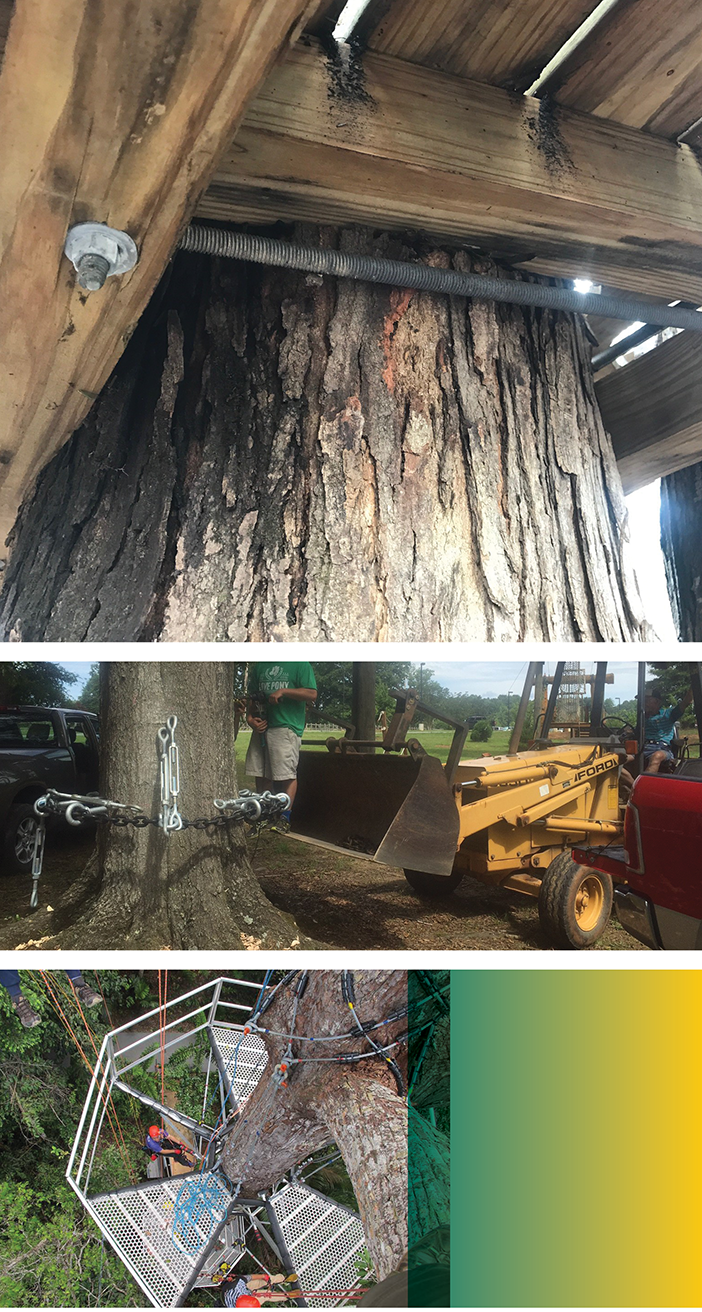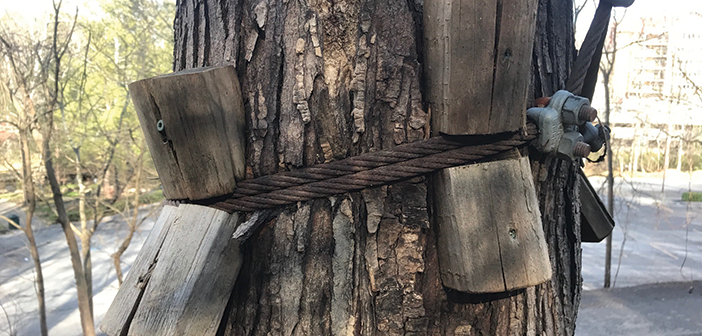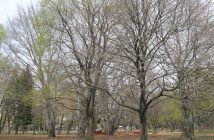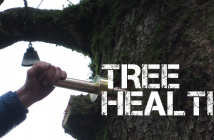A well-known builder and operator of adventure parks contacted me recently to see if I could provide some research references to show why wrapping cables around a client’s oak trees would cause more or less impact to the trees versus a bolted system.
This is a difficult question to answer. The fact is, very little research or studies have been conducted about tree-supported structures and their short- and long-term impacts to the support trees. Studies do exist, though, about the impact of trees growing into infrastructure, such as building foundations and sidewalks. That information can be helpful, but it isn’t specific to our question.
There are a lot of variables that must be considered when building anything in a tree. Expand that to building in a forest and things become even more complicated. Right now, there are several innovative designs of attachments for tree-supported structures that allow long, safe, and useful lifetimes for both the structure and the supporting trees.
Different builders use different methods, and have their reasons for doing so.
Using Bolts
The impacts from bolts that arborists use to reinforce trees that are failing, or to protect areas that are prone to failure from extreme loads, have also been studied. During my 40 years working with trees, I have dissected numerous cable fittings and brace rods from trees that were removed. Discoloration of wood is common, but decay is not.
Generally speaking, if a healthy and vigorous tree of a suitable species has a bolt, few internal problems result, including decay. Well-informed arborists or experienced builders are likely to understand the characteristics of the species of tree they are working with. Appropriate species are likely to be long-lived species that are good at compartmentalizing decay.
Additionally, arborists use their knowledge to avoid drilling a hole into an area where internal decay fungi are already active. This is because they are aware that this may change the tree’s protective boundaries and allow the fungi to move into new areas of the tree’s xylem. Arborists are also aware of the fact that trees become larger in diameter every year, and that their bolts will eventually be enveloped by the tree. In general, this does not present a problem for the type of through bolts and support cable terminations arborists install that hold lateral loads.
Depending on what is being supported, bolts used in tree-supported structures are for directional loads. For instance, static loads from the weight of a treehouse or platform structure, or a cable under tension in the case of a zip line.
Wrap It Up
So, what’s different about wrapping around a tree to secure a cable, or using a compression-type method to attach a platform to a tree? Most important, if no bolts are used to hold blocks in place, for instance, there is ostensibly no penetration and interruption of the cambium. Inevitably, though, a healthy, vigorous tree will expand in circumference every year. How much expansion depends on the species and where it is growing.
As I have covered in earlier articles, if a cable or piece of wood or metal is placed in contact with a growing tree, and is unable to move away with the tree’s yearly growth, the tree will envelop it. Some tree species will girdle, and the portion above the constriction will decline or die.
However, with other tree species, especially those that are fast growing, the tree can envelop the cable or framing member. If the new xylem tissue closes over, sometimes the tree will successfully seal the cable or framing member inside the xylem. The tree now has an intact cambium where the constriction occurred, but the area will likely be a weak spot. Arborists have observed trees breaking where old cables or chains had been enveloped long after the tree closed over the offending material.

Top: A platform installed using simple compression of the framing against the tree trunk. The tree is already beginning to envelop the wood and is cutting off the cambium’s ability to function. This will do significant damage to the tree. Photo: Mike Fischesser Middle: Beanstalk Builders’ “Halo” system being tested under load. It is designed for heavy loads and to accommodate tree growth. Photo: Mike Fischesser Bottom: Malaysian platform using a system of cables “woven” around the tree to support the loads. The idea is that the loads will be distributed, allow the tree to move, and, hopefully, no envelopment will occur. Photo: Tim Kovar
Speaking from Experience
I spoke with several builders of zip lines and challenge courses about their experience with different construction methods. Mike Fischesser, founder of Beanstalk Builders, has decades of experience building challenge courses, and understands tree biology. He is strongly against wrapping and compression after seeing a lot of damaged trees resulting from it over the years. He mentioned that, in many cases, the problems result from no ongoing monitoring and little maintenance. Let that be a warning.
Mike’s goal is to interrupt no more than 10 percent of the cambium of a tree at each level where an attachment is made. He admits there is no science to back up his 10 percent rule, but it’s been successful. In addition, his team calculates the approximate amount of time it will take for tree growth to conflict with an attachment, which is an important metric for a long service life of the structure.
I also spoke with Bonsai Design founder John Walker. I have worked on courses with John that used wrapped cable with wood blocking, and platform attachments that used bolts backed by wooden blocks. John thinks the choice of attachment method should vary with the tree species and environment where the structure is built. He also relies on his experience in many locations.
John says that wrapping is problematic with static cable loads of more than 2000 to 2500 pounds. For lighter loads, and with the proper tree species, he finds that cables with carefully designed and placed blocks can work. John also learned that it is not a good idea to wrap cable all the way around a tree. He previously experimented with several wraps that use friction to spread the loads on very slow growing trees, but has since abandoned that practice.
Experience with certain species in specific areas has helped guide John’s building methods. For instance, in Asheville, N.C., he says that white oak and turkey oak hold up well with blocking and cable, with no discernible problems to date. At properly designed adventure park courses, John says blocks can allow for easier adjustment and easier “tuning” of installations.
Another technique, he says, is to use a spring washer on the platform support bolts placed on the outside of the block. The idea is that the tree will be able to expand as the washer collapses. Additionally, each year—or as needed—they back off the bolt a bit to allow for expansion. He and I have a difference of opinion about this. In most cases, I believe that the new xylem tissue that is pressing against the bolt will be injured when the bolt is moved, and this could cause issues for the tree.
However, I’d be curious to see builders experiment with this idea. That will require building experimentally in trees that can eventually be cut down and dissected to understand what the long-term effects might be in different tree species.
John generally guys his support trees, and in cases where it will be difficult to access and inspect those trees, he will use a bolt with ample room left for the tree to grow.
Robbie Oates of Phoenix Experiential Design prefers to use bolts in his installations, but he has become more open to cable wrapping after seeing evidence of trees doing well despite the cables. Robbie still avoids placing framing members or knee braces flush to trees using bolts.
He is particularly critical of platforms that are held to trees using compression of framing members against the trees. Robbie wants longevity in the courses he builds and a lot of his design thinking reflects that goal. He cites this as a reason that bolts are most often his choice.
Another builder who prefers using bolts is Erik Marter of Synergo. His team does inspections, and is familiar with cable wrapped and compression attachments. I have worked on Synergo courses, and I like the use of a long vertical metal piece that has many anchor holes in it, allowing adjustment or tuning of the system. Platforms are constructed with ample room for tree growth, ensuring a long life for the system.
Arborist Mark Craven of Liminal Feats recently helped decommission a few trees he had wrapped and blocked in 2010, removing platforms and zip lines from chestnut oak and hickory trees. In all cases, the trees showed little or no visual damage.
“There was likely an impact under the bark, but the trees all had healthy new growth in the portion of the column directly above,” he reports. “These days, I bolt almost exclusively, but it’s nice to see that my work from nearly a decade ago hasn’t caused any catastrophic damage (yet).”
Tree Science
All of these builders have some things in common: they have observed trees used for support for many years, they have seen what happens over time, and they have studied tree biology. They are also continuing to learn from their experience and are interested in science that may help them make better decisions.
There is currently a lot of research into tree biomechanics. Arborists want to know more about how trees adapt their structure over time, because that will allow us to make more informed decisions about the stability of trees that might fail and impact humans.
Several scientists are looking specifically at the effects of attachments that are used to support various structures. Many of these are folks based in Europe, and their interest is driven in part by the regulatory environment there.
As I understand, most adventure parks built under the European standards use wrapping and blocks, and require inspection and adjustment on a regular basis. It appears that a primary reason for not using attachments that penetrate trees is because trees are managed with the understanding that they will eventually be harvested! The pressure on the environment there is arguably greater than is typical here.
Scientists interested in tree biomechanics are studying the effects of attaching structures or cables to trees. Consultants such as myself are using technology and engineering science to increase our ability to measure and monitor trees’ strength and stability. That is the kind of information arborists can provide to designers, builders, and inspectors of tree-supported structures.
I have had recent conversations with two adventure park operators who said their ACCT accredited inspector won’t approve the course without an arborist signing off on the structural condition of the trees in use—something many in the industry expect to become more commonplace.
Tree experts interested in the aerial adventure industry will continue to learn and be a resource so builders can provide clients with long-lasting tree-supported elements.
AND NOW,
SOME BASIC ADVICE• A system that wraps cable around a tree using blocks to hold the cable off should only be used for low loads. In these cases, know the growth rate and the bark characteristics of the tree species used, use the least number of blocks possible, do not bolt the blocks in place if it can be avoided, and do not make a full wrap around the tree.
• If using blocks and cable: have a monitoring and maintenance plan that allows for inspection and possibly shifting of the blocks on a regular basis.
• If using bolts or other penetrations of the tree: limit the area of the penetrations to 10 percent of the tree circumference, plan carefully to avoid mistakes, and design to allow at least 20 years of tree growth.






